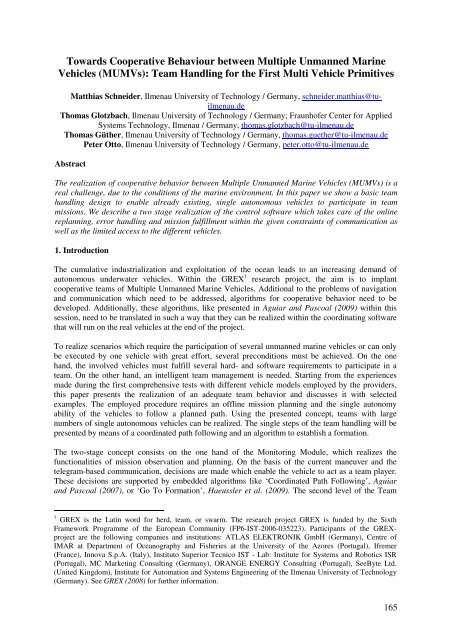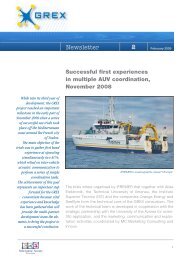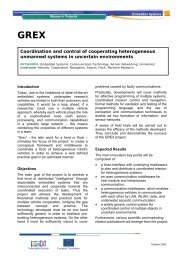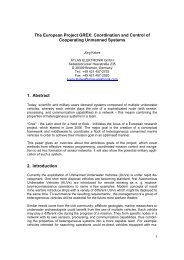Grex Project
Grex Project
Grex Project
You also want an ePaper? Increase the reach of your titles
YUMPU automatically turns print PDFs into web optimized ePapers that Google loves.
Towards Cooperative Behaviour between Multiple Unmanned Marine<br />
Vehicles (MUMVs): Team Handling for the First Multi Vehicle Primitives<br />
Matthias Schneider, Ilmenau University of Technology / Germany, schneider.matthias@tuilmenau.de<br />
Thomas Glotzbach, Ilmenau University of Technology / Germany; Fraunhofer Center for Applied<br />
Systems Technology, Ilmenau / Germany, thomas.glotzbach@tu-ilmenau.de<br />
Thomas Güther, Ilmenau University of Technology / Germany, thomas.guether@tu-ilmenau.de<br />
Peter Otto, Ilmenau University of Technology / Germany, peter.otto@tu-ilmenau.de<br />
Abstract<br />
The realization of cooperative behavior between Multiple Unmanned Marine Vehicles (MUMVs) is a<br />
real challenge, due to the conditions of the marine environment. In this paper we show a basic team<br />
handling design to enable already existing, single autonomous vehicles to participate in team<br />
missions. We describe a two stage realization of the control software which takes care of the online<br />
replanning, error handling and mission fulfillment within the given constraints of communication as<br />
well as the limited access to the different vehicles.<br />
1. Introduction<br />
The cumulative industrialization and exploitation of the ocean leads to an increasing demand of<br />
autonomous underwater vehicles. Within the GREX 1 research project, the aim is to implant<br />
cooperative teams of Multiple Unmanned Marine Vehicles. Additional to the problems of navigation<br />
and communication which need to be addressed, algorithms for cooperative behavior need to be<br />
developed. Additionally, these algorithms, like presented in Aguiar and Pascoal (2009) within this<br />
session, need to be translated in such a way that they can be realized within the coordinating software<br />
that will run on the real vehicles at the end of the project.<br />
To realize scenarios which require the participation of several unmanned marine vehicles or can only<br />
be executed by one vehicle with great effort, several preconditions must be achieved. On the one<br />
hand, the involved vehicles must fulfill several hard- and software requirements to participate in a<br />
team. On the other hand, an intelligent team management is needed. Starting from the experiences<br />
made during the first comprehensive tests with different vehicle models employed by the providers,<br />
this paper presents the realization of an adequate team behavior and discusses it with selected<br />
examples. The employed procedure requires an offline mission planning and the single autonomy<br />
ability of the vehicles to follow a planned path. Using the presented concept, teams with large<br />
numbers of single autonomous vehicles can be realized. The single steps of the team handling will be<br />
presented by means of a coordinated path following and an algorithm to establish a formation.<br />
The two-stage concept consists on the one hand of the Monitoring Module, which realizes the<br />
functionalities of mission observation and planning. On the basis of the current maneuver and the<br />
telegram-based communication, decisions are made which enable the vehicle to act as a team player.<br />
These decisions are supported by embedded algorithms like ‘Coordinated Path Following’, Aguiar<br />
and Pascoal (2007), or ‘Go To Formation’, Haeussler et al. (2009). The second level of the Team<br />
1 GREX is the Latin word for herd, team, or swarm. The research project GREX is funded by the Sixth<br />
Framework Programme of the European Community (FP6-IST-2006-035223). Participants of the GREXproject<br />
are the following companies and institutions: ATLAS ELEKTRONIK GmbH (Germany), Centre of<br />
IMAR at Department of Oceanography and Fisheries at the University of the Azores (Portugal), Ifremer<br />
(France), Innova S.p.A. (Italy), Instituto Superior Tecnico IST - Lab: Institute for Systems and Robotics ISR<br />
(Portugal), MC Marketing Consulting (Germany), ORANGE ENERGY Consulting (Portugal), SeeByte Ltd.<br />
(United Kingdom), Institute for Automation and Systems Engineering of the Ilmenau University of Technology<br />
(Germany). See GREX (2008) for further information.<br />
165
Handler concept is realized by a Replanning Module, which administrates, executes and validates the<br />
replanning commands. While we demonstrated the base functionalities of this concept in Glotzbach et<br />
al. (2008), we will go further into detail now and explain the software realization of the team handler<br />
and of the algorithms for the first realized and tested Multi Vehicle Primitives. With the already<br />
realized functionalities, we are now able to simulate a complete mission from the beginning (vehicles<br />
in the water at arbitrary positions) to the end (vehicles have completed their missions plans and wait at<br />
defined positions for recovery). This mission will be presented using the developed high-level<br />
simulator and employing the original software modules which will later also be used for the real<br />
vehicles.<br />
2. Basic conditions within the GREX research project<br />
The main idea of the GREX project is to develop a middleware system which enables multiple<br />
unmanned marine vehicles to act in a team to perform missions of higher complexity. The basic<br />
modules of the mentioned system are shown in Fig.1. Only through the collaboration of the several<br />
and specialized modules a team oriented behavior can be realized.<br />
Fig.1: GREX middleware system<br />
The Communication Module is responsible for the complete communication between several<br />
vehicles. Team Navigation estimates the position of all team mates based on a complex estimator<br />
structure, the spare position information of the other vehicles and the current track data, like described<br />
in Engel and Kalwa (2007). The Team Handler Module realizes the complete management of a team<br />
and enables the team oriented behavior on a single autonomous vehicle. Due to the use of different<br />
and existing single autonomous vehicles within the GREX research project an Interface Module is<br />
necessary which provides a communication link between the existing vehicle hardware and the GREX<br />
components. Furthermore we have to deal with several constraints. On the one hand there are vehicles<br />
which are able to perform single missions and limited replanning capability. On the other hand we<br />
have the underwater communication with very low bandwidth and high rate of information loss. To<br />
handle these different constraints and provide a save team operating software as well as mission<br />
replanning an intelligent team handling concept is necessary.<br />
3. Multi System Mission Control<br />
Based on the defined structure of the Multi Vehicle Primitives, introduced in Glotzbach et al. (2008),<br />
we are able to provide a conceptual framework to handle teams of multiple unmanned marine<br />
vehicles. The main part of this proposal, the Team Handler core, is shown in Fig.2.<br />
166
Fig.2: Main parts of the Team Handler core<br />
This core provides the basic functionality to handle multi vehicle mission scenarios, including<br />
strategies to adapt the level of autonomy during the mission execution based on external events, and<br />
consists of three main parts which are described in the following chapters. The highest level of the<br />
internal build-up is realized with state machines which were triggered by telegrams. These structures<br />
constitute the base of information flow between the several GREX modules as well as between the<br />
several vehicles within one mission scenario. The telegram types including the build-up of the<br />
structure are predefined. This minimizes the occurrence of an error through modified messages caused<br />
by module or communication failures.<br />
3.1. Data Management<br />
The first part of the Team Handler structure is represented by the Data Management. This passive<br />
object stores the information of all vehicles which take part in a mission as well as the mission<br />
information itself to provide several data for coordination and replanning purposes.<br />
Fig.3: Data management structure<br />
The information has to be stored on every GREX vehicle and will be loaded after the Team Handler<br />
module is started. The basic structure of this module is shown in Fig.3. Furthermore it provides some<br />
simple calculation functionality concerning mission and vehicle data to support the team handling<br />
process through a Functionality Interface. These structures can be extended easily in order to add new<br />
data or features. Due to the use of an external Data Management the Team Handler core is completely<br />
independent from the structure of mission plans or kind of vehicle which should be controlled because<br />
the internal structures are still the same.<br />
167
3.2 Team Initialization Process<br />
The first active part of the Team Handler builds the Initialization Process. Within these routines a first<br />
level of cooperative coordination is realized which is controlled from the Team Handler of the leading<br />
vehicle. Like the other critical parts of the presented structure the single steps of the initialization are<br />
predefined and implemented as state machine.<br />
Fig.4: Main process diagram of the Team Handler with focus on Team Initialization Process<br />
The Initialization Process can be divided in two parts, see Fig.4. On the left side, there are the routines<br />
that initialize the vehicle internal structures like the Team Navigation Module with specified data<br />
from the Data Management or from the vehicle itself. On the right side, functionalities which setup<br />
the team data are implemented. The process of the second part depends if the current vehicle is the<br />
leading one or just a team member. While the Team Handler on the leading vehicle is responsible to<br />
collect the group data to prepare the start of the mission, the member vehicles have to send required<br />
data. After all parts are initialized in the correct way the main process loop, including Mission<br />
Monitoring and Mission Replanning, will start.<br />
3.3. Mission Monitoring<br />
The main control part of the Team Handler structure builds the Mission Monitoring. Based on the<br />
rational behavior model in conjunction with a global state machine this part generates commands for<br />
replanning or information for other modules. Thereby we distinguish between two kinds of Team<br />
Handlers in general. The Team Handler on the leading vehicle and the team handling structures on a<br />
member vehicle. Both are realized identical while the leading vehicle has to fulfill some additional<br />
tasks like the coordination of the group initialization process and the path re-/planning of complex<br />
maneuvers. The role as leading vehicle can be transferred to another vehicle during the mission and<br />
depends on the parameters which were set during the offline planning process.<br />
Fig.5 gives an overview of the main workflow within the Team Handler structure from a more<br />
practical point of view. The focused area points the major tasks of the Mission Monitoring including<br />
the different layers specified by the Rational Behavior Model (RBM). The RBM is a standard<br />
approach for hierarchical control structures in research on mobile robotics, Kwak et al. (1993). Every<br />
layer is realized by at least one function which creates proposals to manipulate the behavior of the<br />
current vehicle in order to activate and keep a team manner within the group of vehicles taking part on<br />
a mission. Thereby the influence of the different layers gets smaller from the Strategic Level down to<br />
the Executive Level.<br />
168
Fig.5: Main process diagram of the Team Handler with focus on Mission Monitoring<br />
The Strategic Level has the highest priority and the ability to abort the complete mission if an error<br />
occurs. Therefore it checks all telegrams which contain error reports of modules or vehicles as well as<br />
denies of replannings. On the other hand this layer is responsible to control the mission activity. If a<br />
new part of the mission (primitive) starts, it initializes the internal states and structures with the new<br />
data. Furthermore the Strategic Layer verifies the current position of the vehicle within the current<br />
primitive and the given global mission area. If any inconsistency is found, the mission will be aborted<br />
for security reasons.<br />
The second layer of the Mission Monitoring builds the Tactical Level. It includes local state machines<br />
which depend on the different Multi Vehicle Primitives that are realized within the Team Handler.<br />
This layer can be extended with algorithms for complex multi vehicle scenarios like GoToFormation<br />
or CoordinatedTargetTracking. Algorithms with a high computing time or ambiguous results are<br />
started in separate and controlled threads as a precaution. Due to this realization there is no critical<br />
impact in the main team handling core. On the other hand the results of complex calculations can also<br />
be used for the complete team e. g. in case of the GoToFormation implementation. If so, the Team<br />
Handler of the leading vehicle calculates and shares the data while the member vehicles have to wait<br />
for it. If the parameters are known, this is done in advance during the standard mission execution to<br />
guarantee a smooth mission cycle.<br />
The Executive Level has just a small priority compared to the other ones but it is executed most<br />
frequently during standard parts (tracks and arcs) of a mission scenario. In general it is responsible to<br />
adapt the speed of its own vehicle to keep the predefined formation based on very fast algorithms, like<br />
suggested in Ghabcheloo et al. (2005).<br />
With the exception of decisions made by the Strategic Level, the results of the different algorithms<br />
(speed adaption, new path, etc.) were passed through the Mission Replanning.<br />
3.4. Mission Replanning<br />
Beside the tactical part of the Team Handler, the Mission Replanning represents the executive part.<br />
After a Mission Monitoring cycle is finished, the main process routine of the Mission Replanning will<br />
be called, replanning or adjustment proposals will be examined and achieved. Fig.6 shows the main<br />
functionalities of this Team Handler component. The dotted line in Fig.6 represents the data transfer<br />
of the replanning or adjustment commands which will be evaluated and sorted by an intelligent<br />
sorting routine. In general this filter works with two main criteria. On the one hand there is the<br />
priority of a command depending on the level of the Mission Monitoring where it comes from. On the<br />
other hand old data can get needless if the mission primitive changed. Based on this replanning<br />
sequence the control part of the Mission Replanning just gets the command with the highest priority.<br />
169
Due to the fact that within GREX the presented solution is one of the first realizations for such kind of<br />
team handling structure and also for vehicle security reasons, only one replanning command is<br />
executed at the same time. Furthermore every order which is send gets a unique identifier that has to<br />
be in the reply message. Depending on the priority of a replanning it is possible that an order will be<br />
denied by the vehicle, e.g. a speed adaptation. A decline of course changes or high priority commands<br />
will end up with a global mission abort realized through an internal message to the Mission<br />
Monitoring component.<br />
Fig.6: Main process diagram of the Team Handler with focus on Mission Replanning<br />
4. Simulation Environment and first results<br />
This external software package provides all data and functionalities which are necessary to simulate<br />
an environment for test purposes from a team handling point of view. It includes e. g. the height above<br />
sea ground, the surrounding sea current or the communication delay as well as data loss as result of<br />
the acoustic underwater communication. Furthermore the Simulation Environment is able to emulate<br />
sensors of a vehicle by calculating the distance to static or dynamic objects like gas concentrations.<br />
Due to the usage of the mentioned data, the GREX simulation software is able to execute missions<br />
with multiple vehicles close to reality.<br />
Fig.7: Simulation Environment<br />
Fig.7 shows the used Simulation Environment with the Environmental Module itself. Every simulated<br />
vehicle needs an interface to the Environment Server to get control relevant data or acoustic messages<br />
from other vehicles. For flexibility reasons it is possible to run the Environment Module and each<br />
simulated vehicle on a separate computer linked by a standard network or the internet. Due to cost<br />
efficiency it is also feasible to run the Environment Module as well as each simulated vehicle on just<br />
one computer.<br />
170
Fig.8: Simulation result with two vehicles<br />
Fig.8 shows a result of a test mission with some explanations at the different states of the example.<br />
The Team Handler structures proposed in this paper provides group control mechanisms in every part<br />
of a mission in terms of speed adaption to guarantee a given formation as well as replannings to allow<br />
complex maneuvers like the shown GoToFormation algorithm.<br />
5. Conclusion<br />
In this paper we described a basic and tested concept which enables the team behavior of single<br />
autonomous unmanned marine vehicles. Due to the generic realization the shown concept is usable for<br />
nearly all kinds of vehicles and also very easy to extend with new control algorithms. Furthermore it<br />
considers the limitations of the current generation of unmanned marine vehicles as well as the marine<br />
environment. The existing vehicle hardware and the internal vehicle control gets just “proposals”<br />
from the team handling structures, there is no active modification. Based on this strategy in<br />
conjunction with the state machines and mission validation within the team handler core a very safe<br />
concept is proposed. Furthermore it provides a test platform for new control algorithms which can be<br />
validated in simulation.<br />
Acknowledgements<br />
The authors gratefully acknowledge financial support of the European Community in the framework<br />
of the research project GREX. The project GREX (FP6-IST-2006-035223) is funded by the Sixth<br />
Framework Programme of the European Community.<br />
171
References<br />
AGUIAR, A. P.; PASCOAL, A. (2007). Coordinated Path-Following Control for Nonlinear Systems<br />
with Logic-Based Communication. 46 th IEEE Conf. on Decision and Control (CDC’07), New Orleans<br />
AGUIAR, A. P.; PASCOAL, A. (2009). Networked Control of Multiple Marine Vehicles under<br />
Communication Constraints. 8 th International Conference on Computer Applications and Information<br />
Technology in the Maritime Industries (COMPIT2009), Budapest<br />
ENGEL, R.; Kalwa, J. (2007). Coordinated Navigation of Multiple Underwater Vehicles. 17th<br />
International Offshore and Polar Engineering Conference (ISOPE-2007), Lisbon, pp. 1066-1072<br />
GHABCHELOO, R.; PASCOAL, A.; SILVESTRE, C.; CARVALHO, D. (2005). Coordinated<br />
Motion Control of Multiple Autonomous Underwater Vehicles. The International Workshop on<br />
Underwater Robotics, Genoa<br />
GLOTZBACH, T.; SCHNEIDER, M.; OTTO, P. (2008). Multi System Mission Control for Teams of<br />
Unmanned Marine Vehicles – Software Structure for Online Replanning of Mission Plans. 7 th Conf.<br />
on Computer Applications and Information Technology in the Maritime Industries (COMPIT2008),<br />
Liege<br />
GREX: Coordination and control of cooperating heterogeneous unmanned systems in uncertain<br />
environments, Home Page, http://www.grex-project.eu, visited on 14/03/2008<br />
HAEUSLER, A.; GHABCHELOO R.; PASCOAL, A. M.; AGUIAR, A. P.; KAMINER, I. (2009).<br />
Temporally and Spatially Deconflicted Path Planning for Multiple Autonomous Marine Vehicles. 8 th<br />
IFAC Int. Conf. on Manoeuvring and Control of Marine Craft<br />
KWAK, S.H.; McGHEE, R.B.; BIHARI, T.E. (1992): Rational Behavior Model: A Tri-level Multiple<br />
Paradigm Architecture for Robot Vehicle Control. Technical Report NPSCS-92-003, Naval<br />
Postgraduate School, Monterey<br />
172







